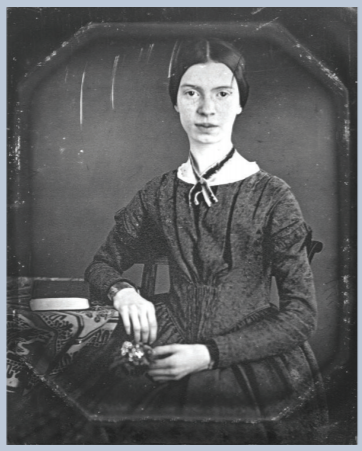5.9: Emily Dickinson's "Because I could not stop for Death" (1863)
- Page ID
- 101419
The following content originally appeared in Writing the Nation: A Concise Introduction to American Literature 1865 to Present by the University System of Georgia, and is used in accordance to license CC BY-SA 4.0.

Born into an influential and socially prominent New England family in 1830, Emily Dickinson benefited from a level of education and mobility that most of her contemporaries, female and male, could not comprehend. The middle child of Edward Dickinson and Emily Norcross, Dickinson, along with her older brother Austin and younger sister Lavinia, received both an extensive formal education and the informal education that came by way of countless visitors to the family homestead during Edward Dickinson’s political career. Contrary to popular depictions of her life, Dickinson did travel outside of Amherst but ultimately chose to remain at home in the close company of family and friends. An intensely private person, Dickinson exerted almost singular control over the distribution of her poetry during her lifetime. That control, coupled with early portrayals of her as reclusive, has led many readers to assume that Dickinson was a fragile and timid figure whose formal, mysterious, concise, and clever poetry revealed the mind of a writer trapped in the rigid gender confines of the nineteenth century. More recent scholarship demonstrates not only the fallacy of Dickinson’s depiction as the ghostly “Belle of Amherst,” but also reveals the technical complexity of her poetry that predates the Modernism of T. S. Eliot, Ezra Pound, William Carlos Williams, and Marianne Moore by almost threequarters of a century. In the selections that follow, Dickinson’s poetry displays both her technical proficiency and her embrace of techniques that were new to the nineteenth century. Like her contemporary Walt Whitman, Dickinson used poetry to show her readers familiar landscapes from a fresh perspective.
"Because I could not stop for Death"
Because I could not stop for Death—
He kindly stopped for me—
The Carriage held but just Ourselves—
And Immortality.
We slowly drove—He knew no haste,
And I had put away
My labor and my leisure too,
For His Civility—
We passed the School, where Children strove
At recess—in the ring—
We passed the Fields of Gazing Grain—
We passed the Setting Sun—
Or rather—He passed Us—
The Dews drew quivering and chill—
For only Gossamer, my Gown—
My Tippet—only Tulle—
We paused before a House that seemed
A Swelling of the Ground—
The Roof was scarcely visible—
The Cornice—in the Ground—
Since then—’tis centuries— and yet
Feels shorter than the Day
I first surmised the Horses’ Heads
Were toward Eternity—

